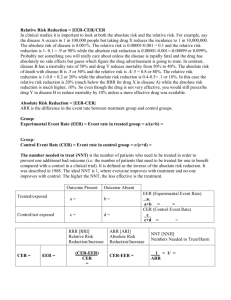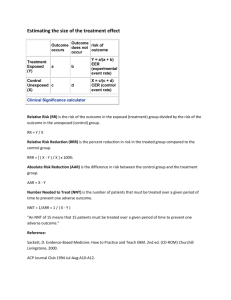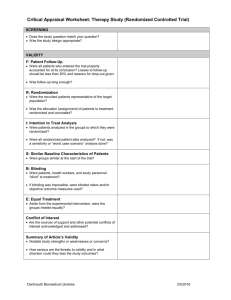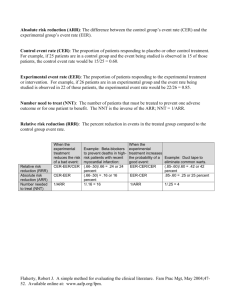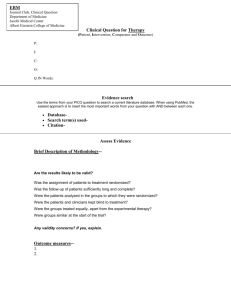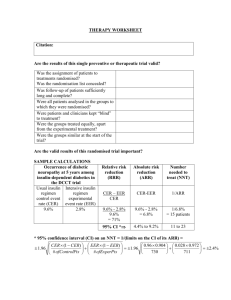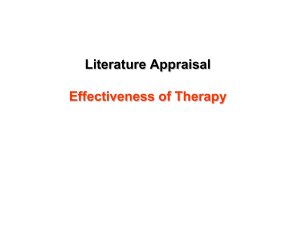ebm - tutorial
advertisement
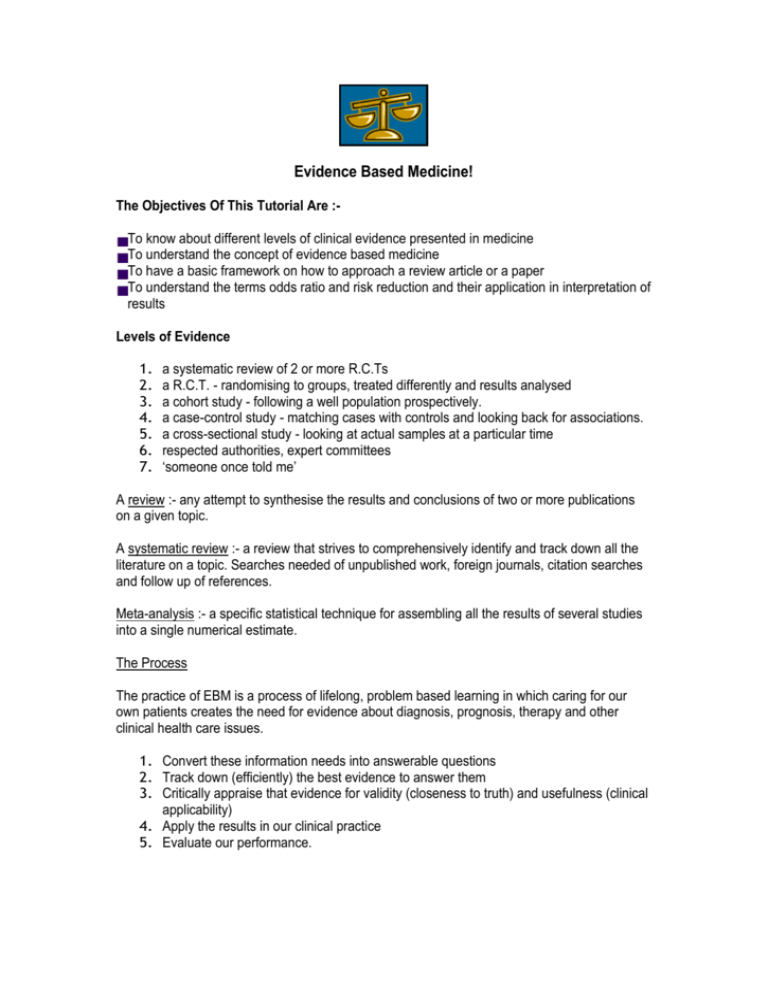
Evidence Based Medicine!
The Objectives Of This Tutorial Are :To know about different levels of clinical evidence presented in medicine
To understand the concept of evidence based medicine
To have a basic framework on how to approach a review article or a paper
To understand the terms odds ratio and risk reduction and their application in interpretation of
results
Levels of Evidence
1.
2.
3.
4.
5.
6.
7.
a systematic review of 2 or more R.C.Ts
a R.C.T. - randomising to groups, treated differently and results analysed
a cohort study - following a well population prospectively.
a case-control study - matching cases with controls and looking back for associations.
a cross-sectional study - looking at actual samples at a particular time
respected authorities, expert committees
‘someone once told me’
A review :- any attempt to synthesise the results and conclusions of two or more publications
on a given topic.
A systematic review :- a review that strives to comprehensively identify and track down all the
literature on a topic. Searches needed of unpublished work, foreign journals, citation searches
and follow up of references.
Meta-analysis :- a specific statistical technique for assembling all the results of several studies
into a single numerical estimate.
The Process
The practice of EBM is a process of lifelong, problem based learning in which caring for our
own patients creates the need for evidence about diagnosis, prognosis, therapy and other
clinical health care issues.
1. Convert these information needs into answerable questions
2. Track down (efficiently) the best evidence to answer them
3. Critically appraise that evidence for validity (closeness to truth) and usefulness (clinical
applicability)
4. Apply the results in our clinical practice
5. Evaluate our performance.
Three principles of EBM in keeping up to date:1. How to practice EBM ourselves (journal clubs etc..)
2. Seek out and apply examples of EBM produced by others
3. Combining evidence based guidelines with validated strategies (audit and feedback)
The Cochrane Collaboration reviews are usually based on the results of RCTs and have an
efficient search strategy.
Making Sense of a Review - ten important questions :1. Address a clearly focused issue?
2. Looked at appropriate sort of papers?
3. Important, relevant studies included?
4. Qualities assessed of these studies?
5. Reasonable to combine results?
6. What is the overall result of the review.
7. How precise are these?
8. Can the results be applied to local population?
9. All outcomes considered?
10.
Are the benefits worth the harm/costs? Oxman, AD et al. JAMA 1994;272(17)
1367-71
Looking at a Paper?
Objectives Worthwhile? Ethical? Results valid? Clearly presented?
Design
Setting
Patients
Outcome
Results
Conclusion
Remember bias, confounding factors
Control Event Rate (CER) = C/C+D
Experiment Event Rate (EER) = A/A+B
Relative Risk = EER/CER { RR=1, no effect; RR>1,favours treat; RR<1,favours no treat }
Relative Risk Reduction (RRR) = CER - EER / CER .......this will be a percentage
Absolute Risk Reduction (ARR) = CER - EER............this will be a percentage
Numbers needed to treat (NNT) = 1 / ARR.........this will be a figure
Control Event Odds = C/D
Experim. Event Odds = A/B
Relative Odds = Odds Ratio = OR = A/B / C/D = AD / BC
Relative risk reduction (RRR) fails to discriminate huge absolute effects and discards the
underlying susceptibility ( or baseline risk ). It cannot tell the difference between huge risks and
benefits from small ones.
In contrast, the absolute differences in the rates clearly do discriminate between these
extremes and is called absolute risk reduction (ARR). Unfortunately, this gives a percentage
and the reciprocal of this will give an easier figure to handle. This is the NNT.
This significance of this figure (?high or low) will depend on clinical significance and not
statistical significance.
We can then compare these figures with other interventions we are familiar with in medicine
and in doing so need to add the dimension of time; i.e. NNT for ?duration to prevent one event.
Ability to convert NNT to our own local patients by dividing NNT figure by F (where F is the
estimated susceptibility of our own untreated patients relative to the average control patient in
the trial ).
Odds Ratio describes the odds of an experimental patient having an event / benefit relative to
a control patient. If interpret odds as risk then risk would be exaggerated especially with events
/ benefits that are more common. The difference between OR and RR increases as event rate
rises.
Odds ratios interfere with clinical application as :1. Not useful at bedside
2. Not even similar to risk reduction in most trials (as common events usually studied). Treating
them the same would overestimate the harm / benefit.
3. Cannot be used to calculate NNT
4. League tables of OR different to RRR.
This tutorial was prepared by Dr J A Crane
